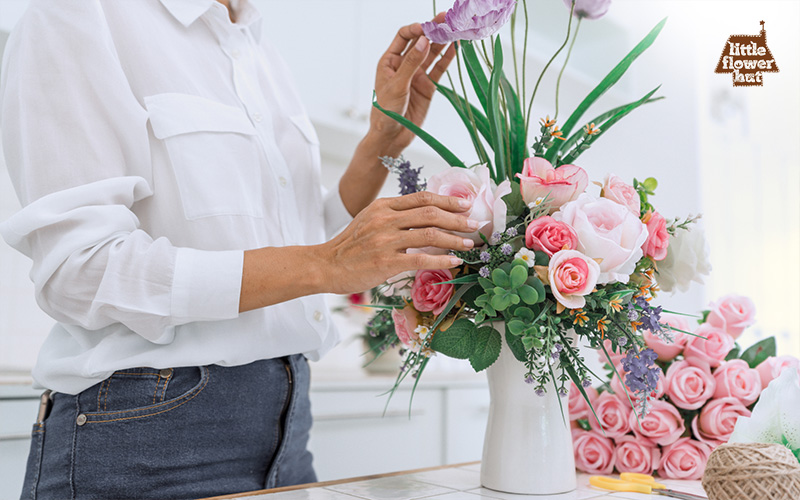blog, Flower Guide
A Deep Dive Into the Art of Floral Arranging
Floral arranging is not just about placing flowers in a vase—it’s about creating a mood, telling a story, and bringing nature’s beauty into your everyday life. For centuries, cultures around the world have utilised flowers not just as decoration, but as symbols and expressions of beauty. Whether it’s the calm elegance of a table arrangement or the vibrant beauty of a cascade, flowers have the power to transform any environment.
Join us as we take a deep dive into the fascinating world of floral arranging, exploring the traditions that have shaped this art and sharing the best tips for beginners and seasoned florists alike.
Understanding Floral Arranging: History and Popular Styles
Cultural and Historical Influences
The history of floral arranging stretches back centuries, with various cultures developing distinctive styles and symbolic meanings associated with flowers.
1. Ikebana
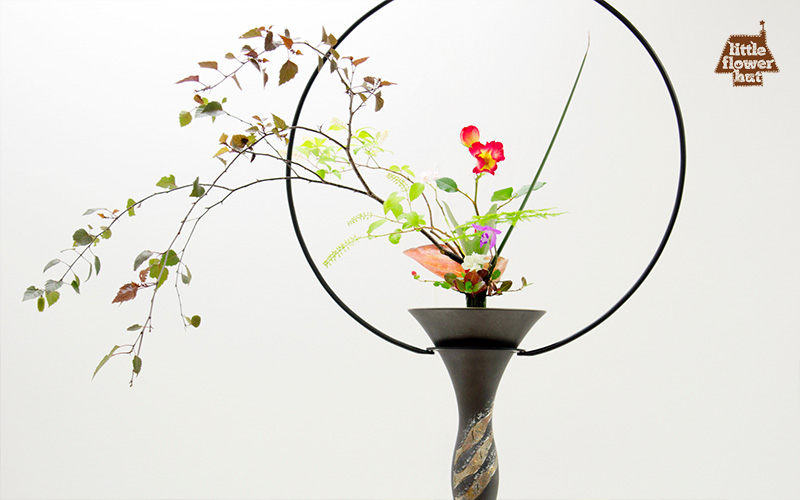
Ikebana, a traditional Japanese art form, uses flowers and other natural materials to convey harmony, simplicity, and the balance between nature and its surroundings. Every element in Ikebana is placed with care and intention, emphasising negative space, minimalism, and asymmetry to bring out the inherent beauty of the flowers.
There are many schools of Ikebana, each with its own unique style and rules, but all share the same fundamental principles. Among these, the Moribana style stands out as one of the most recognised. Moribana arrangements consist of three main elements—primary, secondary, and ornamental stems—each of varying lengths and positioned at specific angles in a shallow container.
The precision required for Ikebana transforms it into more than just a form of floral arranging and into a meditative experience. Practising Ikebana nurtures mindfulness and deepens one’s connection with nature, making each movement intentional and meaningful.
2. Victorian
During the Victorian Era, flowers carried specific meanings, and the art of arranging them became a way to convey hidden messages. This practice, known as floriography, allowed individuals to express sentiments that might otherwise be difficult to articulate directly.
Unlike the minimalist approach of Ikebana, the Victorian floral design was characterised by its elaborate and ornate style. Arrangements were dense, formal, and decorative, reflecting the era’s fascination with order, beauty, and symbolism. Richly layered with a variety of blooms, these designs were often symmetrical and featured intricate patterns, making them a symbol of wealth and refinement. They were prominently displayed as table flowers at weddings, funerals, and other significant events to mark life’s milestones. Today, Victorian-inspired arrangements still evoke a sense of elegance and can be used to create a timeless, romantic atmosphere.
3. European Floral Art
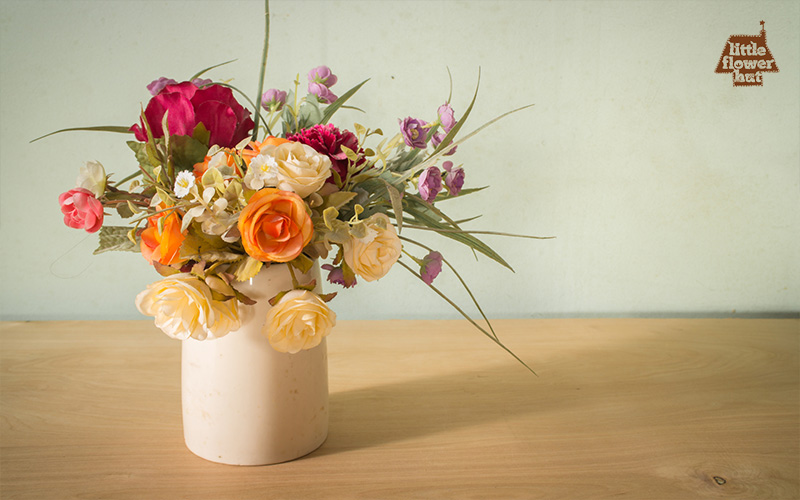
In Europe, flower arrangements differ according to the cultural and historical context of each country. The French floral arranging style, for example, has been through numerous changes over the centuries, from the symmetrical yet relaxed style of the Baroque period to the ornate, curved forms of the Rococo era. Today, it is known for its soft curves, pastel colours, and an overall sense of cohesiveness.
In contrast, Dutch Flemish style of floral design is often more dramatic, with bold colours, intricate compositions, and large showy blooms. While little foliage is used, the Dutch incorporate fruits, vegetables and even elements like bird’s nests and eggs to create a sense of abundance.
Each European tradition has its own unique approach to floral aesthetics, influenced by local flowers, available materials, and the broader cultural significance of flowers in that region.
Popular Floral Arranging Styles Today
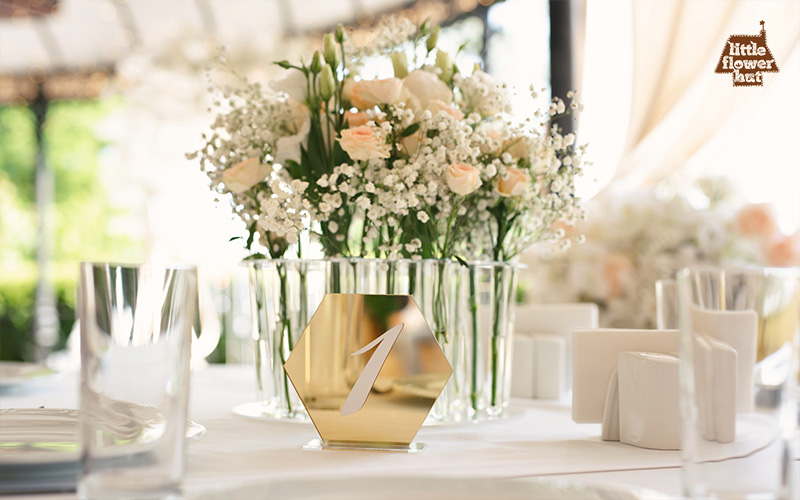
Now that we’ve explored the cultural and historical influences that have shaped floral arranging over the centuries, let’s turn our attention to some of the most popular styles today.
1. Classic Arrangements
Classic floral arrangement styles are all about formal structure and symmetry, featuring traditional flowers like roses, lilies, and orchids. Florists add greenery and foliage to complement the blooms and fill the space, providing a lush and full appearance without being too visually overpowering. In addition, the vessel or container should be understated yet sophisticated, with a simple, clean shape that doesn’t compete with the arrangement.
Classic arrangements can usually be found at weddings, anniversaries, corporate events, or any occasion that requires a polished, refined look. They evoke feelings of timeless beauty and are designed to make a statement.
2. Modern and Minimalist Styles
For those who favour a sleek, contemporary aesthetic, modern arrangements are ideal. This clean, minimalist floral arranging style uses fewer flowers, each often carefully selected for its unique or exotic qualities. Common examples include calla lilies, orchids, birds of paradise, and single-stalk roses. Each bloom is allowed to stand out on its own, drawing attention to its individual beauty rather than overwhelming the viewer with a dense collection. Geometric shapes and sleek containers, such as glass vases or minimalist pots, also enhance the contemporary feel.
3. Rustic and Wildflower Designs
Rustic and wildflower arrangements celebrate the raw beauty of nature. By combining wildflowers, herbs, and foliage, these designs capture the charm of a meadow or garden, bringing the outdoors in. They’re ideal for more relaxed settings, like garden weddings or casual gatherings, where the focus is on natural beauty and an easygoing vibe.
This floral arranging style often includes a variety of textures—from delicate baby’s breath to lush greenery—and features seasonal flowers like sunflowers, daisies, and lavender. Their carefree, organic feel adds a touch of carefree elegance to any event.
4. Themed Arrangements
Themed arrangements are all about capturing the essence of a particular occasion or celebration. Whether it’s a festive holiday, a birthday, or a special event, these arrangements use colours, seasonal flowers, and decorative elements that reflect the mood or theme. For instance, a Christmas bouquet might feature red and white blooms like poinsettias, complemented by evergreen branches and pinecones. For a birthday, bright, cheerful flowers like sunflowers or zinnias take centre stage. These arrangements are also highly customisable, offering a creative way to express your personal style and the spirit of the occasion.
Floral Arranging: Techniques and Tips
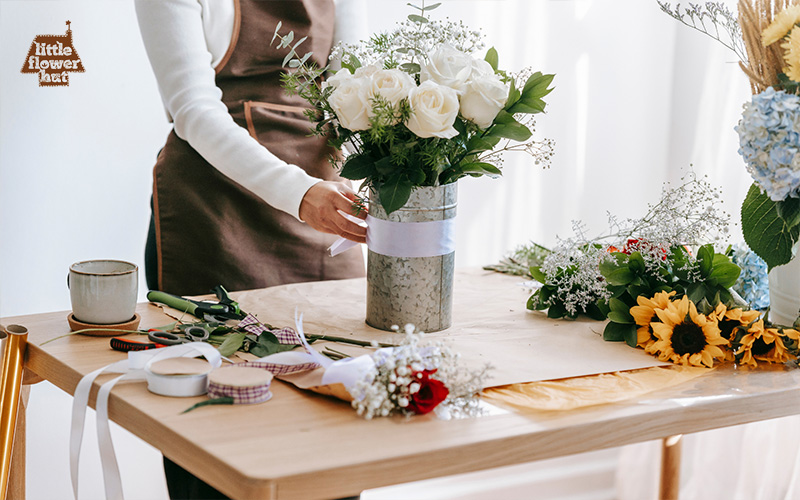
Now, it’s time to delve into the techniques and tips that can help you master the art of floral arranging. From must-have materials to flower design techniques, this section will break down everything you need to know.
Essential Tools and Materials
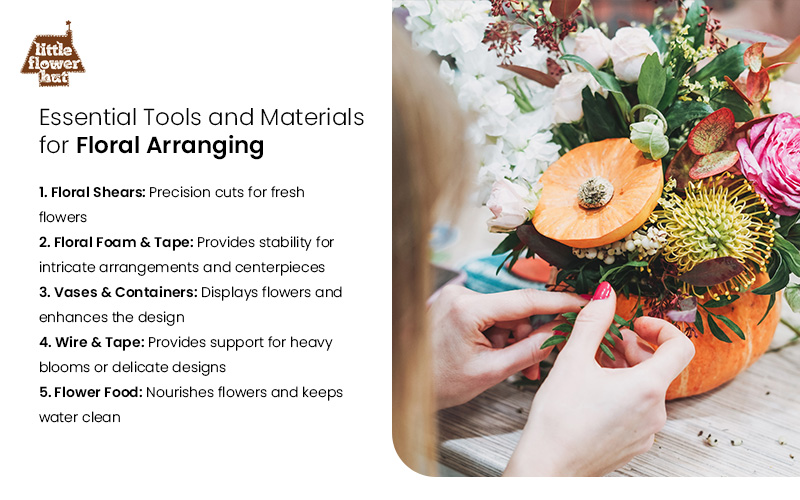
A successful floral arrangement is only as good as the tools and materials used to create it. Here’s a closer look at the essential items every floral designer should have in their toolkit.
1. Floral Shears
Floral shears are a must-have in any florist’s arsenal. These specially designed scissors are crucial for making precise, clean cuts, ensuring that the flowers absorb water properly and remain fresh longer. It’s also important to regularly sharpen your shears to maintain their effectiveness and extend their lifespan, ultimately improving the quality of your arrangements.
2. Floral Foam and Tape
For intricate designs, centrepieces, or arrangements that need to stand independently, floral foam is needed to provide stability and structure. Florists may also use floral tape to create grids, secure individual stems, and reinforce delicate arrangements.
3. Vases and Containers
The container you choose for your arrangement can elevate the design or subtly enhance its theme. Consider the size, shape, and material of the vase as they can greatly affect how the flowers are displayed and the atmosphere they create. The right vase can also provide additional stability to ensure the final result stays balanced and secure.
4. Wire and Tape
Floral wire is a must-have for supporting heavier flowers or creating intricate pieces. It provides extra support to stems that might otherwise droop or sag, such as large blooms like sunflowers or peonies. Wire can also be used to create intricate designs, like wiring flowers into a bouquet or crafting delicate floral structures.
5. Flower Food
Flower food is typically added to the water to provide essential nutrients that nourish the flowers and extend their lifespan. It also works to prevent bacteria from growing in the water, which can shorten the life of your flowers.
The Basic Principles of Floral Arranging
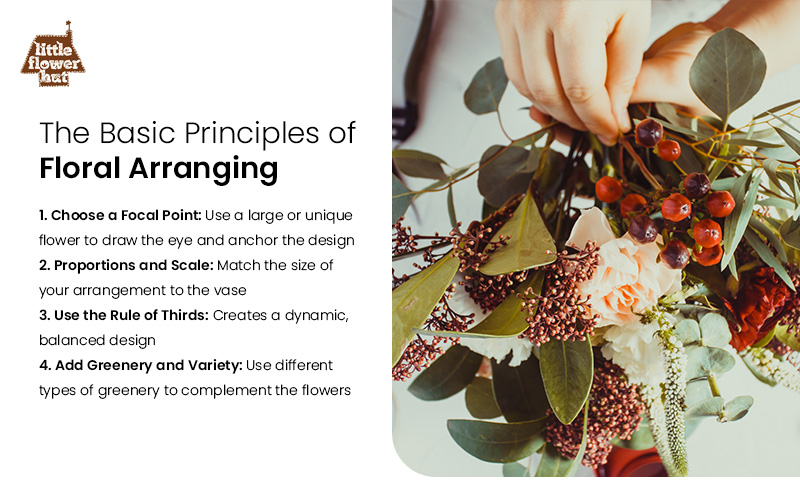
Although floral arranging is an art with endless possibilities, following a few key principles can provide a solid foundation, especially for beginners.
1. Choose a Focal Point
Every floral arrangement should have a focal point, which refers to an element that draws the eye and anchors the design. This could be a large, striking flower like a rose or a unique bloom that stands out among the others. In French-style bouquets, for example, this often involves selecting a single flower type to dominate the arrangement, with the other elements subtly complementing it to enhance its beauty.
2. Proportions and Scale
When arranging flowers, it’s essential to consider the proportions of the arrangement relative to the container. A larger arrangement with bold blooms like sunflowers may need a larger vase to maintain balance and avoid looking too cramps. Conversely, a delicate bouquet with smaller flowers like daisies or baby’s breath will look best in a more compact, slender container. This helps maintain the light, airy feel of the arrangement.
3. Use the Rule of Thirds
The rule of thirds is a simple but effective technique used in many art forms, such as photography and illustration. In botanical art, this method is used to create a sense of balance and movement.
First, divide the arrangement into three equal vertical or horizontal sections. The focal point of the arrangement should be placed off-centre in one of the key sections to draw the viewer’s eye. The other flowers, foliage, or supporting elements are then used to fill the remaining sections. This helps prevent the end result from feeling too rigid or staged, which can happen with overly symmetrical or centred designs.
4. Add Greenery and Variety
No floral arrangement feels truly complete without the addition of greenery. It not only fills out the design but also frames the flowers and draws attention to the blooms. Moreover, the type of foliage you choose makes a difference—from large, broad leaves to delicate sprigs of herbs, each type of greenery adds its own character and contrast.
If you’re eager to learn more about floral arranging and gain hands-on experience, consider joining a flower workshop to further refine your skills and discover new techniques.
Best Flowers for Beginners
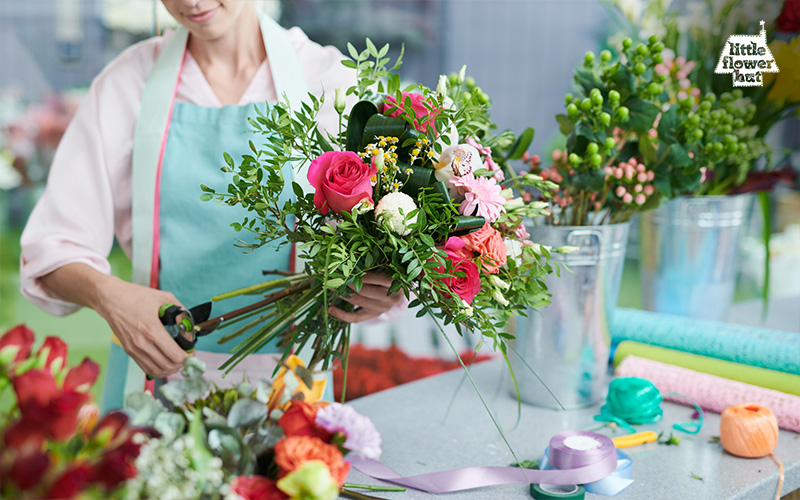
Floral arranging can seem overwhelming at first, but choosing the right flowers can make all the difference in creating beautiful, easy-to-assemble designs. Here’s a list of flowers that are perfect for beginners to work with:
1. Chrysanthemums
Chrysanthemums, or “mums,” are a top choice for beginners in floral arranging. With a wide variety of shapes and colours, they offer great versatility. Their durability and sturdiness make them easy to cut and arrange, while their long-lasting nature ensures your arrangements stay fresh for longer.
2. Sunflowers
Sunflowers are excellent flowers for arrangements thanks to their size, ease of handling, and bold visual impact. Their large, radiant blooms are naturally eye-catching, making them perfect as a focal point. Additionally, they have thick, strong stems that are easy to cut and place, which means that they require less precision than more delicate flowers.
3. Carnations
Carnations are known for their frilled, soft petals and rich colour palette, making them a crowd favourite. Their long-lasting nature also means that they hold up well in arrangements, even in warm settings. Plus, their structure lends itself to different arrangement styles, from tight, compact carnation bouquets to more airy, open designs.
4. Zinnias
Zinnias have a striking, almost geometric appearance, with their bold, layered petals and wide range of hues, from bright pinks to deep oranges. Their resilience and cheerful disposition make them a popular choice for summer arrangements, while their variety of shapes and colours gives beginners plenty of options for mixing and matching in different floral designs.
Frequently Asked Questions About Floral Arranging
How do I care for my arrangements to make them last longer?
Some tips for keeping your flower arrangements looking their best for as long as possible include:
- Changing the water in the vase every two to three days to prevent bacteria buildup and ensure your flowers stay hydrated.
- Re-cutting the stems at a 45-degree angle to allow for better water absorption.
- Placing the arrangement in a cool, shaded area, away from direct sunlight and heat sources.
Can I mix fresh and artificial flowers in an arrangement?
Yes, you can! Mixing fresh and artificial flowers can create a unique arrangement. Just ensure that the artificial flowers match the colours and style of the fresh ones, and use the fresh flowers as the focal point while the artificial blooms fill out the arrangement. This combination can be particularly effective when you want to create a long-lasting display with a natural look.
How can I determine if my flowers are fresh?
Fresh flowers should have firm, healthy stems and vibrant, unblemished petals. The leaves should be green and robust, without any yellowing or browning. The flowers should feel firm to the touch, and there should be no wilting or limpness. Additionally, fresh flowers typically emit a subtle, pleasant fragrance, though some varieties may not have a strong scent.
When purchasing from a florist, always check for these signs of freshness to ensure your bouquet will stay beautiful for as long as possible.
Conclusion
Whether you’re preparing for a special event, giving a heartfelt gift, or simply adding a fresh touch to your home, flowers have a unique way of making everything feel more vibrant. The beauty of floral arranging lies in its endless possibilities—so feel free to experiment, explore new techniques, and find your own style.
If you’re looking for professional arrangements that leave a lasting impression, Little Flower Hut is here to help. Our expert florists craft stunning bouquets tailored to your needs, ensuring every occasion is celebrated with beauty and elegance. Plus, our express delivery services ensure your flowers arrive fresh and on time, adding a touch of magic to any event.
Get in touch with us today.

